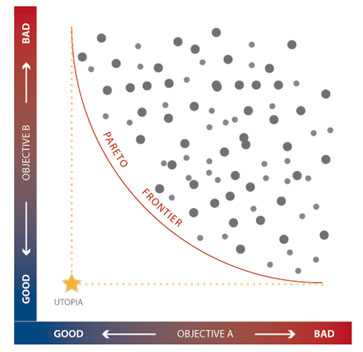Multiobjective Optimization

The prevalence of complex engineered systems has resulted in multiobjective optimization playing a very significant role in engineering. A multi-objective approach to optimization allows solutions to be found to real-world problems that usually originate from several interdependent dischiplines. With a multiobjective approach, the "optimum" solution takes on a broader meaning in that it refers to a set of goals, as opposed to a single goal, that should be improved at the same time. In a nutshell a multiobjective analysis tries to find a set of good compromises rather than a single solution.
The Pareto Optimization
Today, engineers are increasingly asked to solve problems using a multi-criteria decision making process that takes a more open view of the complete problem. Collaborative optimization avoids the design problems that arise when engineers committed to perfecting their part, do this at the expense of the product as a whole. It ensures that engineers with different skills and possibly from different corporate departments work together to find an optimal overall solution for the best production methods of the product as a whole.
This collaborative approach is referred to as multiobjective optimization (or Pareto optimization). By no longer focusing on a single target at a time it offers a more powerful view of the problem since several conflicting goals can be optimized in relation to each other.
The Added Value of a Multiobjective Optimization
With a multiobjective approach, the notion of optimum has evolved because we no longer focus on a single target but try to improve a set of goals concurrently. In a nutshell, the aim of a multiobjective optimization is to find a set of efficient compromises rather than a single solution.
In fact, a multiobjective optimization does not produce a unique solution but a set of efficient solutions. These solutions are called Pareto solutions and the set of solutions that is Pareto efficient is known as the Pareto frontier.
Having a set of efficient solutions, rather than a single one, provides engineers with a more robust approach and a broader general view of the problem under consideration, which is of enormous assistance in their final decision making. Having a set of optimal options means that, if something changes in the original scenario, the engineer can respond with another efficient solution already available in the basket of efficient choices.
The Numerical Aspects of Multiobjective Optimization
Optimization refers to making the best choice from a range of possible alternatives. Therefore, the multi-objective optimization of a problem means finding the best set of points representing all the compromises between conflicting objectives. This set of points is known as the Pareto frontier. In terms of numerical algorithms, optimization can be a very complex task since an enormous number of possible combinations must be tested when using a brute force approach.
In real-world applications there are several sources of complexity that need to be considered when solving an optimization problem such as the:
- accuracy of modeling the physics
- number of free variables
- number of objectives
- number of constraints
- linear vs. non-linear response
The coupling of disciplines can however be a challenging task, introducing limitations on the computational resources or lack of communication between different corporate departments.
Metaheuristic methods, such as multiobjective genetic algorithms and evolutionary strategies, are new types of optimization methods that have been developed since the 1980s. These methods have the ability to solve even the most daunting optimization problems in the most efficient way possible, and have significantly contributed to the growth of multiobjective optimization as a stand-alone discipline.
